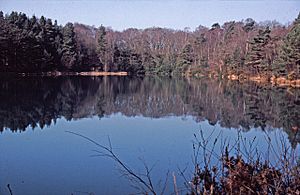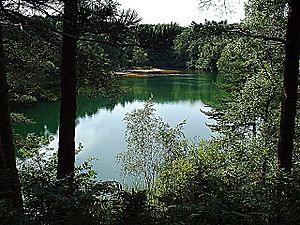Blue Pool, Dorset facts for kids
The Blue Pool is a unique lake located in Dorset, southern England. It's found within the Furzebrook Estate, a large area of heathland and woodland near Furzebrook on the Isle of Purbeck. This special place was once a busy clay pit where a type of clay called Purbeck ball clay was dug out. Today, it's a peaceful and popular spot for visitors.
The Furzebrook Estate is about 5 kilometers (3 miles) south of Wareham and 3 kilometers (2 miles) west of Corfe Castle.
Contents
The History of Blue Pool
The story of Blue Pool began a long time ago, in the early 1600s. Back then, it was a pit where chalk was mined. Later, from the mid-1600s to the early 1900s, it became a place where Purbeck ball clay was dug up. This special clay was used to make fine ceramic items. Imagine your favorite mug or a fancy teapot – this clay helped create them! It was also used for things like smoking pipes.
The clay pit stopped being used before the First World War. However, even today, ball clay is still mined from other pits in the area.
Why is it Called the Blue Pool?
You might wonder why it's called the 'Blue Pool' when the water often looks turquoise. The amazing color comes from tiny bits of clay floating in the water. These tiny particles are so small that they are in a special mixture called a colloidal suspension.
Depending on the size of these particles, they scatter light in different ways. This can make the water appear in many shades, from red-brown or grey to green, and most often, a beautiful turquoise. Sometimes, in photos, the water might look a metallic blue. This is usually just the reflection of the sky, as the pool's own website describes it as "a turquoise jewel."
Nature and Wildlife at Blue Pool
The Blue Pool is not just pretty; it's also a very important place for nature. In 1985, the estate was named a Site of Special Scientific Interest. This means it's now protected by law to help save its rare plants and animals. Parts of the site are even managed as nature reserves by groups like the Amphibian and Reptile Conservation Trust.
The pool is surrounded by 25 acres of heathland. Here, you can find rare plants like the Dorset heath and the marsh gentian. The estate has many sandy paths that let you explore the area.
The plants around the pool are home to many animals. You might spot grey squirrels, rabbits, and badgers. The estate is also a safe home for many rare birds, amphibians, and reptiles. If you're lucky, you could see a Dartford warbler or a nightjar. Two of Britain's protected reptiles, the green sand lizard and the smooth snake, also live here in good numbers. You'll also see many dragonflies and even the rare Sika deer.
Visiting Blue Pool Today
Today, Blue Pool is a very popular place for visitors. People love to come here for its peaceful and quiet atmosphere. There's a café where you can grab a snack, a museum to learn more about the area, and a gift shop.
The paths around the pool are easy to walk on. There are steps down to the water's edge and on some paths. But don't worry, there's also a completely flat route around the pool, which is great for wheelchairs or strollers.



